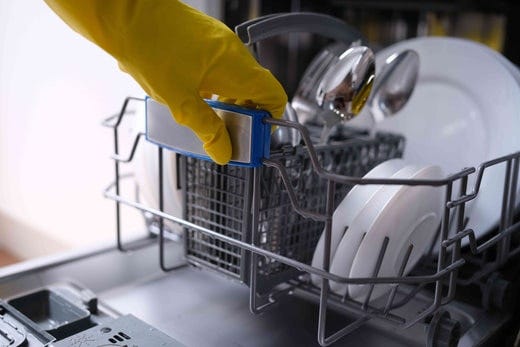Guide to Parts of a Dishwasher

In kitchen appliances, few hold as much importance as the dishwasher, a powerful, modern marvel that is convenient, saves water and energy, is safe and easier, and helps you efficiently keep your dishes and utensils clean.
Yet, behind the sleek exterior lies a very complicated system of components working together to give you sparkling clean dishes after every wash. Every element is pivotal in the dishwasher’s operations, from the water inlet valve to the heating element.
In this guide, we explore the various essential parts of a dishwasher, unveiling their functions and significance.
Whether you are a seasoned dishwasher user or have just started using one, understanding these parts is important to maximizing efficiency and ensuring the longevity of your dishwasher.
The inside parts of a dishwasher
We’ll help you get acquainted with the most common dishwasher parts.
1. The heating Heating element
Located at the bottom of the dishwasher tub and raises the water and air temperature for the wash cycle and drying, respectively. If the dishware isn’t dry properly after the wash cycle, the heating element should be inspected for any problems.
2. Detergent and rinse aid dispenser
A small, rectangular-shaped container with a latch is typically located inside the dishwasher door. The dishwasher detergent dispenser releases the detergent, such as Finish Ultimate All in 1 tablet, at the most optimal time during the wash cycle. Keep a close eye on the dispenser, as detergent build-up can prevent it from working properly.
While not universal to all dishwasher models, the rinse aid dispenser releases the Finish Rinse Aid during the final rinsing to reduce water spots on the dishes and glassware and improve drying performance.
3. Control Panel
Located at the front or top of the dishwasher door, providing easy access to the dishwasher program & cycles, and settings.
It usually comprises buttons and pads; in some dishwasher models, it may consist of an LCD or touchscreen. It may also indicate an error message and failing dishwasher components.
4. Rack, rack supports, and accessories
Normally, a dishwasher contains two racks, but larger models can have a third rack. They are made of metal wires with a protective nylon or polyvinyl chloride coating, making them durable and able to withstand water, heat, and weight.
Racks are connected to the tub through a rack support system, including a track, a few wheels, and a stopper to prevent it from getting ejected.
5. Silverware basket
Usually made of plastic, this movable silverware basket can often be found on the inner door panel or as detachable brackets that sit on or hang from the dishwasher racks.
6. Spray arms
Depending on the model, dishwashers have two or three spray arms that rotate and blast hot water around the tub to ensure even water distribution.
Usually, one spray arm is underneath the upper rack and sprays water on the dishes in the top rack, while the second is below the bottom rack. If parts of your dishes aren’t clean enough, the spray arm assembly might be stuck.
7. Door latch
Located beneath the plastic cover of the inner door, the latch is responsible for securing the dishwasher door, flipping the safety switch, and notifying the appliance that the cycle can begin.
The dishwasher door latch is important to ensure your dishes are properly contained and cleaned inside the tub.
8. Water inlet valve
The water inlet valve controls the water flow into the dishwasher in a corner behind the kick plate.
9. Circulation pump and motor
The circulation pump and motor regulate water pressure into the spray arms and filtration system.
10. Filtration system
The dishwasher filtration system consists of a filter at the bottom of the tub underneath the lower rack. It prevents clogging by removing food particles from the wash water so it doesn’t end up back on the dishes and filtering out the dirty water.
Learn about dishwasher filters and how to clean them, from spotting the signs that they’re overdue to cleaning to the different filters available.
.png?width=70&height=45&format=png&quality=50)